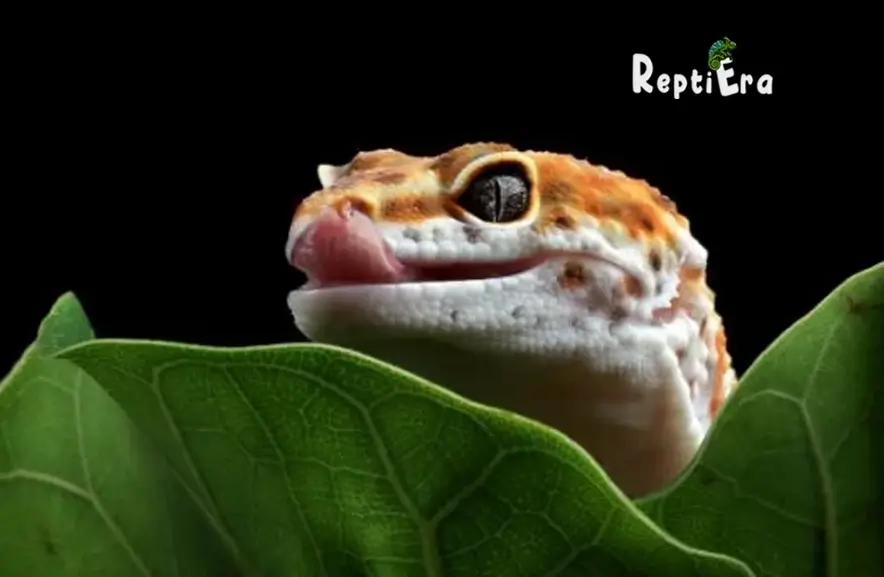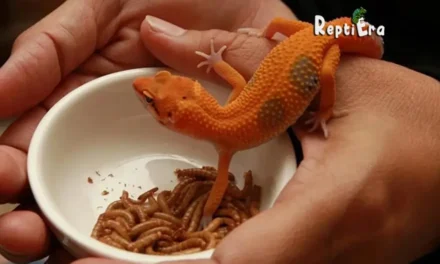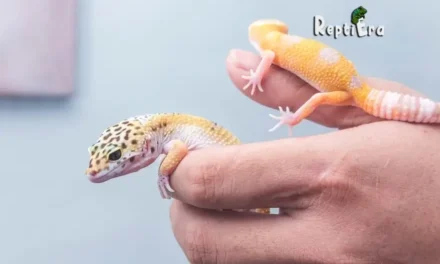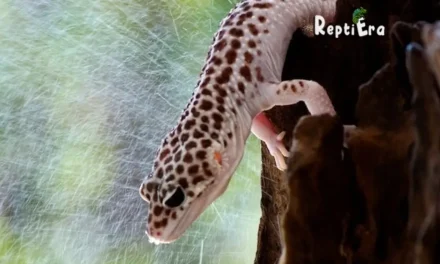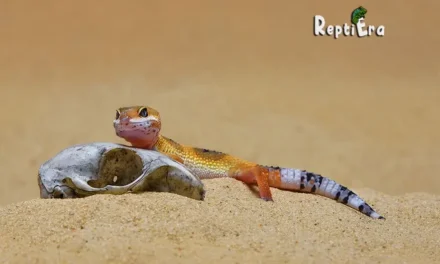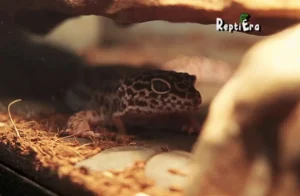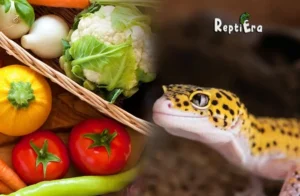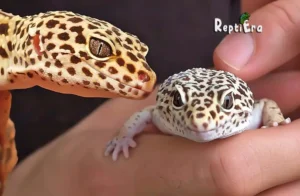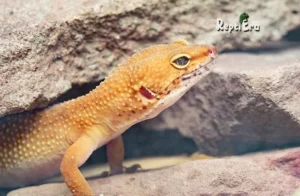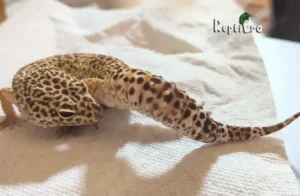In the exciting world of pet ownership, we often find ourselves wondering what goes on in our pets’ heads. We attempt to communicate with our pets, trying to understand their language. Yet, with little success, the mysteries of their behaviours remain. This is especially true for Leopard geckos, intriguing animals known to display their emotions through vocal and posture cues. These creatures are not overly loud, quite the opposite in fact, producing only a handful of various sounds like screaming, barking, clicking, and chirping.
If you have arrived at this article, you’ve probably experienced a strange noise coming from your Leo and, like many, have turned to surfing the web and learning about these unique noises. Eventually, you ended up asking, “Why do leopard geckos chirp?”
It’s a question that leads many to delve into the specific behaviour of these geckos. Little research has been published examining this, but it is suggested that chirping could be due to the gecko feeling threatened, stressed, hungry, suffering from incorrect handling, or displaying a mating display. In some cases, it could even indicate happiness!
Leopard geckos make several noises, each with its own significance. As a pet owner, I’ve observed these various sounds from time to time. The chirping is particularly unique, sometimes suggesting that the gecko is either feeling threatened or stressed. In the wild, these vocalizations can signal territorial disputes or mating calls. Interestingly, in a domestic setting, such incorrect handling or feeling hungry can also trigger these sounds.
This article aims to shed light on the unique noises of the leopard gecko, enhancing our understanding and appreciation of these fascinating creatures.
Table of Contents
What Does It Mean To Chirp?
In the world of keeping leopard geckos, one intriguing aspect is deciphering the various sounds these little critters make. As lizards, they are not inherently vocal like birds or dogs, often leaning towards the mute side. However, Leos have their own array of different noises they produce, and understanding what each sound means can be a fascinating journey.
The chirp is one such sound that is both difficult to discern and subtle. As an owner, you learn to listen closely to your Leo, comparing the sounds you hear to resources like a video or vocal patterns described by other enthusiasts. These reptiles express themselves through screaming, chirping, sometimes referred to as squeaking, along with clicking and barking. Each sound has its own context and significance.
Screaming in leopard geckos is notably unique, a loud, obvious, and shrill expression, typically seen in juveniles not yet accustomed to humans. It’s a defensive mechanism designed to scare away predators. Unlike the self-explanatory nature of a dog’s bark, the barking in geckos is not as straightforward. It’s a series of hoarse sounds, forming a pattern more akin to a repetitive sequence of short noises. This is a toned-down warning message, a step down in their defence strategy.
On the other hand, chirping and clicking often have varied interpretations. While science and speculation offer varying opinions online about the exact meaning of chirps, it generally indicates a need or emotion that the gecko is trying to communicate. Whether it’s a sign of comfort or distress, deciphering the meaning behind these sounds can lead us closer to understanding the root of our reptile friend’s emotions and needs, and interpreting the signs they display.
Also Read: DO LEOPARD GECKOS NEED SUBSTRATE?
Why Do Leopard Geckos Chirp?
In our quest to explore the unique sound of leopard geckos chirping, we delve into a fascinating aspect of their behaviour. This chirping, a distinct form of communication, serves as a window into their otherwise mysterious world. Unravelling the reasons behind this unique sound enhances our understanding of these captivating reptiles, enriching our experience as caretakers and observers.
Reason 1: Your Leopard Gecko Is Not Used To Its New Home
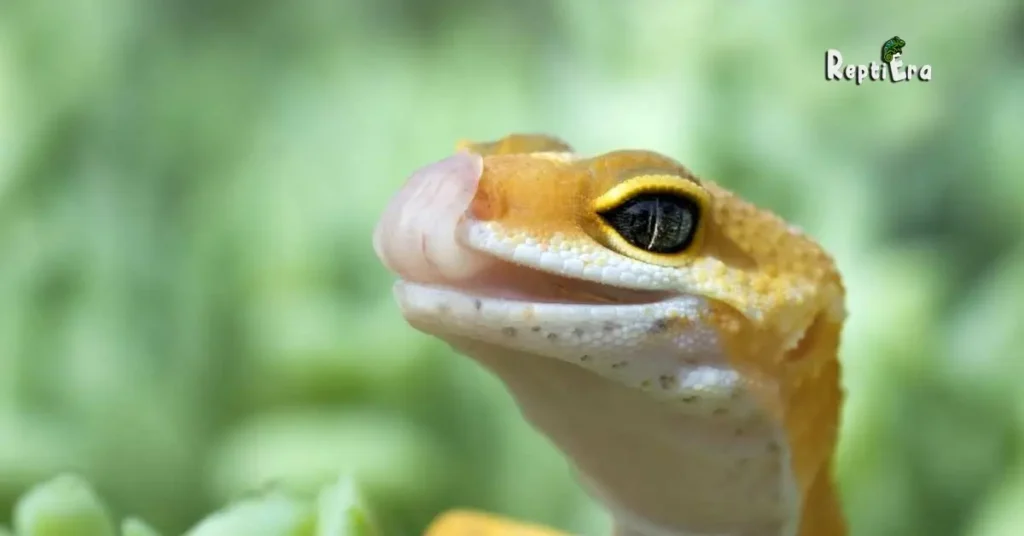
When you hear chirps and clicks from your leopard gecko, it’s often a sign they’re stressed about their new home. As a seasoned leopard gecko owner, I’ve learned to be patient, especially in the first 2 weeks after bringing them home. It’s a critical time for them to get used to their new environment. Many pet owners, myself included, get excited to handle and show off their new pet, envisioning spending time with them outside their habitat or keeping them company while visiting family and friends.
However, patience is indeed a virtue with these reptiles. Their journey from the pet store or breeder to your home is significant, and it’s important to allow at least 14 days for their relaxation. This helps them understand that they’re in a safe place.
In these early days, limit your interactions with your gecko to hands-off activities within their habitat, like cleaning and feeding. This introducing process involves placing your hand in their enclosure and leaving it there for a few minutes each night, briefly and calmly, so they get used to your presence. Reasons for stress can vary, but one common issue I’ve noticed is the reaction to fragrances.
Geckos have a keen sense of smell, and they might react negatively to perfumes, lotions, or other products with a strong fragrance. It’s recommended to wash your hands with unscented, biobased soap before handling your gecko, as some scents can be dangerous to them. Over time, with patience and understanding, your leopard gecko will learn that your hands and presence mean well, helping them settle into their new home more comfortably.
Related Post: WHY IS MY LEOPARD GECKO DIGGING
Reason 2: The Leopard Gecko Enclosure Isn’t Ideal
If your leopard gecko is frequently making chirps and clicks, it’s likely due to the set-up of their enclosure. When I first started reading up on gecko care, I hadn’t considered opting for a tank that opens from the front, the reasoning being that it can reduce stress when your hand approaches them.
Adjusting their lives to be less stressful doesn’t just reduce their vocalizations; it’s also financially and logistically less trouble in the long run. I learned this the hard way after picking up a tank from Amazon without considering Leo’s perspective. To a gecko, a foreign object reaching down from above gets closer, smells funny, or looks different than anything they’ve seen—like shiny objects or rings and jewelry—can be startling.
Tip: An ideal home for them involves random intervals of quiet during the day, a clean bathroom area, and no uneaten food lingering around, all of which make them feel more comfortable and reduce stress-induced vocalizations.
Reason 3: They’re Feeling Threatened
When it comes to understanding why leopard geckos chirp, especially when they feel threatened or scared, it’s crucial not to doubt or blame the natural instincts of these petite lizards. In the wild, their survival depends on constant vigilance and an acute sense of fear of predators.
Even in the safe place of a carefully designed enclosure, devoid of any real threat to kill them, leopard geckos may still exhibit instinctual responses. They chirp as a physical, instinctual response to ward off perceived hazards and protect themselves. These random noises, a form of non-verbal language, are often misunderstood by humans who may fail to comprehend their true meaning.
Leopard geckos use body posture and vocal adaptations as part of their threat display. Actions like tail flicking, wiggling, tense limbs, biting, and scurrying swiftly are their way of dealing with perceived danger. These actions are designed to startle predators and facilitate a quick retreat to safety. As pet owners, witnessing these behaviours can be amusing, but we must respect and understand them.
By resolving and eliminating these stressors, you can help your pet feel more comfortable and calm, thus reducing their need to communicate in such a manner. This approach not only ensures the well-being of your pet but also deepens your connection, fostering an environment where they can feel secure and protected.
Also Read: WHY IS MY LEOPARD GECKO ALWAYS HIDING
Reason 4: Incorrect Handling
Handling juvenile leopard geckos can be a delicate matter, as they often chirp when handled incorrectly. Unlike adult geckos, which become familiar with their owners and the sensation of being held, juveniles are new to this world and can feel insecure in their environment, particularly when adopted into a new home.
To these baby leos, a giant hand may seem like a predator, instilling fear for their lives. They are, after all, reptiles with a strong survival instinct. When you scoop them up, chirping may ensue, leaving you taken aback. It’s important to let them settle into their new surroundings and gradually start the bonding process. Interactions should be slow and in short intervals to limit stress and be as gentle as possible with your new buddy.
For an adult Leo, being picked up can still trigger chirping, as each individual is different. Some may have been rescued as adults or might be skittish by nature, afraid or introverted, and not accepting of friendship with humans easily. Others might chirp after they have eaten or are about to shed.
Tip: Holding them tightly or squeezing them can create discomfort, and they may not always feel like being social. Young geckos can be particularly afraid when handled roughly. If your gecko starts chirping, it’s best to leave them alone; these are not sounds of enjoyment. Give them some alone time and try again later, respecting their space and comfort levels.
Reason 5: Use Of Intervals In Handling Prevents Clicking
To prevent your leopard gecko from making clicking noises, which often indicate discomfort, incorporating intervals in handling can be a simple yet effective strategy. Start with sessions as short as five minutes at a time, and always handle them gently. This means reaching your hand slowly into their enclosure, placing it near them, and supporting their belly, tail, and feet carefully. NEVER grab or drop them.
In the first week, try handling them every other day, and in the next week, you can gradually increase the frequency. It’s advised to seat yourself on the ground while handling them to prevent any potential jumps or falls onto a soft surface. Remember, it’s a bad idea to let them interact with other pets like cats or dogs, and they should be kept out of the room during handling sessions.
Leopard geckos are crepuscular creatures, so it’s important to understand their dislike for being disturbed during their active time, which is usually day and night, especially in the early mornings or later evenings. Be diligent in your training, and pay attention to their chirps and clicks as indicators of dislike for being held. Remember, it’s nothing personal; respecting your pet’s preferences is key. If they show signs of discomfort, it’s best to place them back in their tank ASAP and gently resume handling another time.
Reason 6: Mating Calls
In the context of mating calls, the chirping of a sexually mature male leopard gecko becomes a focal point. Around the age of 18 to 24 months, when they reach a weight range of 35-40g, male geckos are ready to breed. Owners, especially those new to the home of a leopard gecko, should pay attention to these behaviours.
The reason for their chirping is quite fascinating: males court females in a somewhat humorous fashion, frantically shaking their tails much like a rattlesnake. This display is meant to entice and impress the female. Females, in contrast, tend to lay low and stay quiet, observing the males’ efforts. During the breeding season, male geckos might also chirp while fighting for territory with other males. To avoid such conflicts, it’s advised to house male geckos alone or independently from other geckos, especially as they reach full size and maturity.
For those with baby leopard geckos, you might not yet witness this love dance and its accompanying sounds. However, as your pet grows, you will start to observe these unique behaviours. Each chirp has a reason, and as dedicated caretakers, we keep looking for these subtle cues to understand and care for our scaly companions better. These natural behaviours, although different from human interactions, offer a glimpse into the fascinating world of reptile communication and social dynamics.
Reason 7: They’re Unhappy Or Stressed
Typically, leopard geckos don’t make much noise when they are happy; in fact, it’s often the opposite. Under certain circumstances, a Leo might communicate discomfort or unease, which needs to be remedied. When unhappy or stressed, these geckos may exhibit behaviours like chirping. One should examine the enclosure setup, as an incorrect housing layout can contribute to their discomfort.
Factors such as an improper temperature gradient, humidity fluctuations, or a lack of hides and enrichment decor can lead to insecurity and boredom. Ensuring a comfortable and entertaining environment is key, with tools like a thermometer and hydrometer aiding in watching and adjusting heat and humidity levels.
When upgrading the tank to a larger size, the new and unfamiliar layout can make a gecko scared and stressed, particularly if it has just been adopted and is being introduced to its new home. Stress and anxiety in leopard geckos, much like their prey counterparts in the wild, can be simple to determine but harder to decide the root of the tension.
Paying attention to when your gecko chirps, its body posture, and changes in behaviour, like tail flicking, can help identify the stimuli in the surrounding environment causing discontentment. Recognizing these signs is the first step in finding a solution, helping your gecko to adjust, settle, and reduce tension. This approach will lead to a more quiet and calm pet, ensuring they feel safe in their abode.
Reason 8: Territorial Behavior In Leopard Geckos
When you have two leopard geckos as roommates, it’s vital to recognize that they can’t always get along, especially if they’re males. Housing male geckos together should be avoided, as they tend to fight over territory, creating a stressful environment. Females might live together in a large tank—ideally 20-30 gallons—which is perfect for Leos.
Especially with males, the result of them feeling their space is threatened can often be clicking noises. I’ve learned that when you hear these sounds in your house, it’s time to consider providing a second tank, ready in case cohabitation doesn’t work out. Even when you try to ensure peace, sometimes the natural instincts of these reptiles take over, and it’s best to be prepared for such eventualities.
Related Post: CAN LEOPARD GECKOS LIVE TOGETHER
Reason 9: Their Crickets Are Stressing Them Out
Crickets are a popular food choice for leopard geckos, who generally enjoy this easy-to-come-by prey available in local pet shops or shipped to your home. However, as a pet owner, it’s important to understand that these insects can sometimes bite and bother your gecko inside their tank, acting as unexpected stressors.
The constant jumping and attacking behaviour of crickets can be distressing for geckos, so it’s wise to follow certain tips to keep feeding sessions safe and stress-free. Opt for crickets of the right size—baby crickets for juvenile geckos and larger ones for adults. Ensure they are gut-loaded before feeding to provide maximum nutrition. Only give one or two crickets at a time to avoid your gecko being overpowered.
It’s helpful to pick up crickets with tweezers or bamboo tools to disable their ability to jump and potentially harm your gecko. This also helps to simulate a hunting experience for your gecko in a controlled environment. Monitor how your gecko eats and remove any uneaten crickets promptly to prevent them from causing undue stress or harm to your pet.
By managing the cricket-feeding process carefully, you can significantly reduce the likelihood of your leopard gecko feeling stressed and resorting to chirping or clicking noises as a response to these tiny but potentially aggravating invaders in their habitat.
Reason 10: They’re Hungry
In my years of caring for leopard geckos, I’ve often noticed a peculiar behaviour – they tend to get quite noisy around dinner time, especially when their mealtime is behind schedule. This chirping, a distinct sound from these generally quiet creatures, is akin to a display of both excitement and a gentle reminder that their belly is empty.
Once, when I was a few hours late for their feeding, the intensity of their chirps stirring the tank with almost eager anticipation was unmistakable. It’s fascinating to realize that these chirps aren’t just random noises but a form of communication, a way for them to speak about their needs.
During a recent observation, I made detailed notes of this happening. As I entered the room with a container of delicious insects, their usual food, the chirping reached its peak. It was a clear sight of hunger pangs and understanding the reason behind their vocalizations was key.
As I began feeding them, their chirps transformed into audible expressions of gratitude, almost as if they sang a song of delight at the sight of food arriving. Realizing this, I felt a sense of relief and stress reduction, knowing that their vocalizations were not a sign of being upset or unhealthy, but rather an expression of their natural behaviour and needs.
Reason 11: Your Leopard Gecko Might Fear Other Pets

If you own other animals like cats or dogs that roam around your home, it’s important to remember these beloved family members, while friendly, can appear quite intimidating to a tiny animal like a leopard gecko. These larger animals might view your gecko as a curious toy, so make sure they are kept away from your gecko’s space.
My gecko, Leo, once caught sight of a large animal nearby and immediately began to feel threatened and stressed, which caused him to start making chirping and clicking noises. As we’ve discussed, this can be a result of feeling threatened by the presence of larger pets. To prevent your leopard gecko from getting stressed out, it’s crucial to ensure a safe and secluded tank environment, away from the curious gaze and potential stressors posed by other household pets.
Reason 12:They’re Actually Just Happy
As a longtime owner of a leopard gecko affectionately named Leo, I’ve come to recognize the rhyme and reason behind their chirping noises. It’s not random; rather, these chirps often conclude with a display of happiness. Leo tends to let me know he’s content when relaxing in his favourite spot – be it a couch in his tank or a cozy corner of his bed.
This comfortable environment seems to elicit chirps of sheer contentment. Owners of these charming reptiles, like myself, often attest to this behaviour, especially when their buddy appears excited about seeing or hearing them. I often joke that I am Leo’s sole provider of food and fun, and it seems like he agrees, displaying his emotions in his own unique ways.
How To Understand The Reason Behind The Chirps
Understanding the chirping at random times in Leo’s life can be difficult to comprehend for any leopard gecko owner. As an enthusiast myself, I’ve learned that it’s crucial to tell what’s happening by gathering clues about the reason behind each sound. Look out for changes in their eating and activity levels.
Loss of appetite or lethargy are often tell-tale signs that something might be wrong internally, and these should be addressed immediately. These symptoms could indicate stress, fear, or sickness. Keeping an eye out for their body posture and stance is also vital. A puffed-up body, arms held tight, or standing tall could be a signal of aggression or defence against a perceived threat, triggering their vocalizations.
In contrast, a relaxed posture with no apparent distress typically means they are happy and comfortable. Just like humans, these animals communicate not only vocally but also through gestures and posture. Tail flicking, an open mouth, or a certain way they hold themselves can all be part of this communication.
Learning to interpret these signs has helped me understand when my gecko is simply enjoying life or if there’s a deeper issue at play. It’s a fascinating aspect of leo’s life, decoding his unique way of expressing his feelings and needs, and it’s a reminder of the complex ways in which even small creatures like leopard geckos interact with their environment and their human companions.
Also Read: WHY IS MY LEOPARD GECKO TRYING TO ESCAPE
The 4 Most Common Leopard Gecko Sounds to Listen For
1. Chirping and Squeaking
Chirping and squeaking are common sounds in the world of leopard geckos. If you notice your gecko making these sounds, you’re in luck, as they’re typically connected to feelings of happiness, enjoyment, and pleasure. When these geckos roam around their tank, becoming more vocal, especially around feeding time, it’s a great sign that they are happy and at ease in their environment.
2. Clicking
Clicking is a common sound among leopard geckos and can be a positive indication or signify that they are uncomfortable, annoyed, or stressed. Whether you hear this from younger or older geckos, particularly those not fully accustomed to humans, it’s likely a reaction to handling, having recently eaten, or post-shedding. Recognize this stressed noise and if you hear it, it’s best to stop what you’re doing and give them space to relax.
3. Barking
While barking is less common than clicking in leopard geckos, it’s a significant sign that the gecko is stressed. This way of sound production is slightly hoarse and is a less common but more serious response. Geckos typically bark when they feel in direct danger or are extremely uncomfortable and annoyed.
4. Screaming
Screaming is the least common sound you’ll hear from a leopard gecko, and it’s a key sign they’re scared or sense danger. Adult geckos rarely resort to this, but a juvenile might scream a lot; expect quite a bit of noise as they need time to become patient and gentle during this stage. As the gecko grows and becomes more accustomed to its surroundings, they typically grow out of the screaming phase.
FAQs
Why does leopard gecko chirp?
While observed in wild geckos, chirping is often a sign of being angry or startled; it’s common in animals raised in captivity to be more vocal for different reasons than their wild cousins.
Why did my leopard gecko scream at me?
Screaming or shrieking is a rare vocalization in leopard geckos, usually when they feel threatened or afraid, emitting a high-pitched screeching sound that lasts a few seconds; generally, they scream to startle or scare something they perceive as threatening.
Can leopard geckos feel pain?
Many recent scientific studies have shown that reptiles, including leopard geckos, possess the necessary neurotransmitters and anatomy to feel pain.
Why do geckos make a weird noise?
In the case of the Tropical House gecko, males often make sounds to attract female mates, with chirping acting as signals alongside pheromones to show females they’re interested; these calls allow them to mate or signal fighting over territory with other males.
Conclusion
Recognizing the difference in the sound of leopard geckos’ chirps can be difficult but not impossible, with practice. Ultimately, the answer to why they chirp is multifaceted. Mostly, we can’t read the mind of Leo, but there are several reasons causing this behaviour. Take note of what’s happening at the time you hear them chirp, focusing on body movements and the surrounding stimuli.
These sounds can occur due to fear, stress, perceived threats, incorrect handling, during mating seasons, or when they’re hungry or happy. There’s no doubt that their chirps can surprise you with their cryptic noises, but as you understand and distinguish these, you’ll realize these reptiles produce a range of vocalizations. If a chirp is long and there’s nothing else to worry about, it’s likely just a part of their natural expression.
As a caretaker of a leopard gecko named Leo, I’ve learned that ensuring Leo’s environment is stress-free is key to avoiding the sounds of chirping. While these chirps might seem cute, it’s important to remember they’re not for our entertainment’s sake. Be sure to regularly check their habitat for any stressors and address them promptly. A happy gecko is usually a quiet one, and understanding this aspect of their behaviour is crucial for any responsible pet owner.

